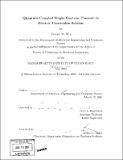Quantum-coupled single-electron thermal to electric conversion scheme
Author(s)
Wu, Dennis M. (Dennis Meng-Jiao)
DownloadFull printable version (12.66Mb)
Other Contributors
Massachusetts Institute of Technology. Dept. of Electrical Engineering and Computer Science.
Advisor
Peter L. Hagelstein.
Terms of use
Metadata
Show full item recordAbstract
A new thermal to electric conversion scheme based on an excitation transfer and tunneling mechanism is studied theoretically. Coulomb coupling dominates when the hot side and the cold side are very close. Two important concepts went into the device scheme: (1) Coulomb coupling, to try to increase throughput power (which is not subject to blackbody limit), and (2) a quantum dot implementation, to restrict number of states, to try to increase efficiency. Modeling efforts from Bloch equations, brute force numerical simulations, and the secular equations partitioning method are discussed. A hot-side quantum dot design of the device is considered. Alternative implementation where the hot-side is a plain sheet of metal or aluminum oxide is analyzed. We found that the model power/area is higher than the blackbody limit, and the predicted conversion efficiency is very high.
Description
Includes bibliographical references (p. 236-242). Thesis (Ph. D.)--Massachusetts Institute of Technology, Dept. of Electrical Engineering and Computer Science, February 2008.
Date issued
2008Department
Massachusetts Institute of Technology. Department of Electrical Engineering and Computer SciencePublisher
Massachusetts Institute of Technology
Keywords
Electrical Engineering and Computer Science.